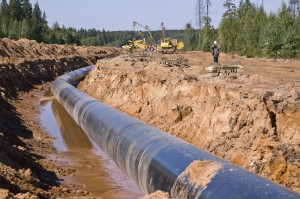 The Sabin Center has just published a new report on the consideration of climate change in federal Environmental Impact Statements (EISs) prepared under the National Environmental Policy Act (NEPA). The report describes the results from a survey of 238 federal EISs published from July 2012 through December 2014. The survey is a follow-up to a prior assessment of climate change considerations published from January 2009 through July 2012. The report is accompanied by an excel database which lists each of the EISs that was surveyed and identifies where and how these EISs discuss specific topics related to climate change.
The Sabin Center has just published a new report on the consideration of climate change in federal Environmental Impact Statements (EISs) prepared under the National Environmental Policy Act (NEPA). The report describes the results from a survey of 238 federal EISs published from July 2012 through December 2014. The survey is a follow-up to a prior assessment of climate change considerations published from January 2009 through July 2012. The report is accompanied by an excel database which lists each of the EISs that was surveyed and identifies where and how these EISs discuss specific topics related to climate change.
Key Findings – Federal agencies generally do account for climate change when conducting environmental reviews of projects that will generate greenhouse gas (GHG) emissions or be affected by climate-related phenomena such as sea level rise. Of the 238 federal EISs reviewed in this survey, 214 (90%) contained some discussion of GHG emissions or climate change impacts. Notably, considerations related to climate change mitigation and adaptation were addressed in roughly the same number of EISs: 172 (72%) discussed GHG emissions associated with the proposed action, and 167 (70%) discussed how climate change may affect the proposed action and/or the surrounding environment. In contrast, only 91 EISs (38%) discussed energy efficiency, and only 31 (13%) discussed water efficiency. Some additional findings are summarized below.
Lifecycle Emissions from Fossil Fuel Extraction and Transportation – Out of nineteen EISs that involved proposals for fossil fuel extraction or transportation infrastructure, only three conducted a lifecycle assessment of GHG emissions from the extraction, transportation and consumption of these resources. These included the Department of State’s EIS for the Keystone XL Pipeline, the U.S. Forest Service (USFS)’s review of two federal coal lease modifications, and USFS’s review of an oil and gas leasing project in Fishlake National Forest. Some of the other EISs in this category briefly discussed indirect impacts on GHG emissions—for example, the Federal Energy Regulatory Commission (FERC) stated in several EISs that the approval of natural gas pipelines would actually reduce GHG emissions by displacing more carbon intensive coal use—but they did not contain a complete assessment of downstream and/or upstream emissions.
Carbon Sequestration and Vegetation Management – USFS lacked a standard approach to evaluating the effect of vegetation management activities on carbon sequestration and GHG emissions. In many EISs, USFS acknowledged that these activities would affect carbon storage capacity and emissions, but asserted that it was not possible to quantify those effects.[1] However, in three EISs prepared during roughly the same period, USFS did conduct a quantitative analysis of these impacts. [2]
Climate Change Impacts and Adaptation – Although most (70%) of the EISs contained some discussion of how climate change would affect the proposed action or its surrounding environment, the discussion tended to be quite brief and the findings did not typically influence the agency’s decisions about project design, location, environmental mitigation measures, or other aspects of the proposed action. This was true even for some coastal infrastructure projects (e.g., bridges and roads), where the agency would cite sea level rise projections without discussing implications for the design or location of the project. [3] There were a handful of exemplary EISs that contained an in depth analysis of climate change impacts and adaptation options, primarily in the context of decisions about how to manage public lands and parks.[4] Some even provided for continuous monitoring and the implementation of mitigation measures in the event of certain impacts (e.g., if water levels in a river were to fall below a particular threshold, the agency would reevaluate water allocations for park services). [5] These EISs could serve as a guidepost for similar proposals. The Sabin Center has also developed a set of model protocols for evaluating the impacts of climate change on buildings and infrastructure undergoing environmental reviews, and we intend to develop similar protocols for natural resource and land management projects.
The full report, accompanying database, and previous EIS surveys are available here.
[1] See, e.g., Final Environmental Impact Statement: Rim-Paunina Project 514 (Jan. 2013); Final Environmental Impact Statement: McKay Fuels and Vegetation Management Project at 331 (May 2013); Final Environmental Impact Statement: Lakewood Southeast Project 146 (Aug. 2013); Final Environmental Impact Statement: Beaver Creek Project at L-11 (Jan. 2014); East Reservoir Final Environmental Impact Statement 40 (Mar. 2014).
[2] Final Environmental Impact Statement: Whisky Ridge Ecological Restoration Project at 81-88 (May 2013); Final Environmental Impact Statement for the Revised Land Management Plan: Kootenai National Forest at 111 (Aug. 2013); Rim Fire Recovery Environmental Impact Statement 69-71 (Aug. 2014).
[3] See, e.g., Fed. Highway Admin., U.S. Dep’t of Transp. & TX Dep’t of Transp., CSJ: 0101-06-095, US 181 Harbor Bridge Project Final Environmental Impact Statement/ Section 4(f) Evaluation 3-97 (Nov. 2014) (failing to discuss the implications of projected sea level rise on the design or location of a bridge in the coastal city of Corpus Christi, TX).
[4] See, e.g., U.S. Forest Serv., U.S. Dep’t of Agriculture, R8-MB 143 A, Final Environmental Impact Statement for the George Washington National Forest Land and Resource Management Plan at 3-76 – 3-88 (Nov. 2014) (addressing, directly, the effects of expected climate change and methods for reducing vulnerability to such effects); U.S. Fish & Wildlife Serv., U.S. Dep’t of the Interior, Malheur National Wildlife Refuge Final Comprehensive Conservation Plan and Environmental Impact Statement at 3-6 – 3-13, app. M (Dec. 2012) (same); Nat’l Park Serv., U.S. Dept. of the Interior, Merced Wild and Scenic River Final Comprehensive Management Plan and Environmental Impact Statement at 9-101, 9-128, 9-137 – 9-138, 9-148, 9-159, 9-169, 9-212 – 9-213, 9-246, 9-262, 9-278, 9-293, 9-309, 9-332 – 9-333, 9-360, 9-371, 9-383, 9-396, 9-407 – 9-408 (Feb. 2014); Nat’l Park Serv., U.S. Dept. of the Interior, Tuolumne Wild and Science River Final Comprehensive Management Plan and Environmental Impact Statement at ES-6, 5-42, 5-93, 5-95-5-96, 6-25 (Feb. 2014) (same).
[5] See, e.g., Nat’l Park Serv., Tuolumne EIS, supra note 15, at ES-6, 5-42, 5-93-5-96, 6-25 (providing for continuous monitoring of the river’s free flowing condition and alternative or enhanced action in the event of adverse impact); U.S. Fish & Wildlife Serv., Malheur EIS, supra note 4, at 3-12–3-13 (detailing climate change adaptation and restoration strategies, including ongoing monitoring of local climate, streamflow, and other environmental factors).


